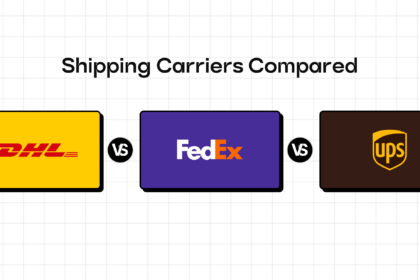In an ideal world, shipping with carriers like UPS would be as smooth as butter. But unfortunately, that’s not the case. E-commerce businesses that deal with unexpected fees, billing discrepancies, and delayed deliveries, turning a key leg of their customer journey wobbly as customer satisfaction dwindles and shipping costs rise.
This is where e-commerce businesses need a robust UPS shipping audit to save the day. Akin to a behind-the-scenes detective, a UPS shipping audit positions a magnifying glass on all service failures and undue charges that could be eating away at your bottom line.
But what is it, and more importantly, how do e-commerce businesses go about it? Well, find answers to these questions and more right here in our guide to UPS shipping audits in 2025.
Understanding UPS Shipping
United Parcel Service, better known as UPS, is a leading package delivery company that is based in the United States of America. 1.6 million shipping customers use this shipping company to deliver to 10.1 million customers in 200+ countries daily. As of 2024, UPS delivered an average of 22.4 million packages every day, rounding up to 5.7 billion in the year.
With a robust shipping network across the world, UPS has come to become a popular carrier for e-commerce businesses worldwide.x`
What is a Shipping Audit?
A shipping audit refers to the exercise of analyzing your shipping invoices to identify billing errors, overcharges, undue ancillary charges, and other discrepancies that could be causing you to overpay for shipping. Further, the process of verifying invoices also allows you to identify service failures and raise claims in time to gain compensation from your carrier.
Benefits of Conducting a UPS Shipping Audit
If you’re on the fence regarding whether you should integrate UPS shipping audits into your operations, let’s make it easier for you—Yes! You definitely should, and here’s why:
Uncover Errors and Overcharges
A UPS shipping audit helps you recognize billing errors and discrepancies that could be bleeding your e-commerce business. Some common issues identified by a UPS shipping audit include:
- Duplicate charges: A single package gets mistakenly billed more than once.
- Missing Discounts: UPS misses out on calculating your bill with promised discounts.
- Inaccurate Package Weight: A package gets billed under an incorrect weight category, driving up its cost.
- Incorrect Surcharges: Unjustified inflated charges added to your shipping bills.
Facilitates Refund Claims
UPS, like other carriers, offers certain service guarantees, according to which e-commerce businesses are entitled to compensation in the form of refunds or credits in case UPS falters. Issues attracting refunds include damage/loss of package, delivery to the wrong address, etc. However, claims must be initiated within a specific period.
By helping you analyze and verify UPS shipping invoices, a robust UPS shipping audit facilitates accurate and timely claim requests, ensuring you file for compensation within the refund window.
Facilitates Compliance
UPS shipping audits help you confirm your shipping operations are in tandem with your carrier contracts and other regulations, helping you avoid legal action, penalties, and fines.
Drives Financial Accuracy
UPS shipping audits help you maintain correct and updated financial records, which enhance financial decision-making and budget planning. You see, periodic audits reduce the chances of overlooking billing errors or missing out on a refund from UPS.
Supports Customer Satisfaction
Auditing your UPS shipping invoices helps you ensure your deliveries are timely and efficient, which contributes to customer satisfaction and, by extension, customer retention.
Steps to Conduct a UPS Shipping Audit
So, how do we go about facilitating a UPS shipping audit, you ask? Here’s a step-by-step guide:
1. Collect Your Shipping Audit Data
Gather all required documents and details you need to verify and confirm your shipping invoices. Examples include carrier contracts, discount details, UPS refund policies, etc.
2. Examine Shipping Audit Data
Verify your shipping invoices by cross-checking their details with internal records, contracts, policies, etc.
3. Raise Claims
Submit claims with UPS for the service failures you found while auditing your invoices.
4. Collect Credits and Refunds
After UPS has processed your claim, it will issue the refund.
How to Audit UPS Shipments
You can audit your UPS shipments in three ways:
Manually
This involves manually undertaking the verification of UPS shipment invoices. Since UPS shipment auditing requires careful checks that often involve combing through invoices and cross-checking the details with carrier contracts, promised discounts and carrier policies, this process is naturally tedious and prone to errors if done manually.
Engaging a Third-Party Parcel Audit Service
E-commerce businesses can consider outsourcing their UPS shipping audit processes to third-party parcel audit firms. However, this can be expensive and require you to share sensitive customer data.
Integrating a Parcel Audit Solution
This is a software that automates your shipping audit process end to end. It starts by analyzing your shipping invoices for errors, flagging said errors, filing for claims, and ensuring you receive the money due to you.
Further, these advanced tools also track carrier performance to give you insight into your carrier’s efficiency, facilitating informed decision-making at the time of contract negotiations.
Common Mistakes to Avoid in Shipping Audits
Here’s a look at some of the most common mistakes that e-commerce businesses make when undertaking shipping audits:
Not Conducting Regular Shipping Audits
Shipping audits are not a one-and-done deal but an ongoing exercise that you must undertake periodically. Analyzing and verifying your invoices, collating them with your internal records and contracts, and extracting data only once in a while will not only give you a skewed and unreliable picture of your shipping operations, but it will also make it conducive to invoice errors and service failures to fall through the cracks.
Poor Record Keeping
Make sure you maintain meticulous records of all your shipments to facilitate ease of shipping audits. This means filing away carrier contracts carefully, staying updated with promised discounts, tracking your packages and their details (weight, value, date of shipment, etc.), and the like in an organized format so that when it comes time to audit your invoices, you can do so hassle-free.
Failing to Leverage Automation
Lastly, e-commerce businesses might think they can facilitate manual shipping audits, but with the sheer volume of shipments, you’ll soon realize that the process is not only resource-intensive but highly prone to errors as well. And so, consider integrating LateShipment.com’s Parcel Audit and Shipping Refund software. This advanced tool scans invoices to identify service failures, billing errors, etc., in a matter of minutes. Not only that, but it also raises claims, and if they get denied, LateShipment.com’s expert team escalates the matter to ensure you get every last cent due to you.
Future Trends in Shipping Audits
The expected future trends in shipping audits include an increased adoption of AI and anomaly detection to drive error recognition, blockchain for improved security and transparency, streamlining the auditing process, and smart contracts that ensure transactions take place only when specified conditions are met.
Conclusion
A UPS shipping audit isn’t just about catching billing errors—it’s about taking control of your logistics, cutting unnecessary costs, and ensuring your customers get their orders on time. With the right approach, you can turn what seems like a tedious process into a powerful strategy for boosting efficiency and profitability.
But let’s be honest—who has time to manually track every shipment? That’s where LateShipment.com’s Parcel Audit and Shipping Refund software comes in.
It automatically detects billing errors, claims refunds on your behalf, and helps you optimize your shipping strategy—in the process facilitating as much as 20% savings on shipping costs.
If you’re serious about saving money and improving your shipping operations, it’s time to let automation do the heavy lifting. Ready to reclaim what’s rightfully yours?









